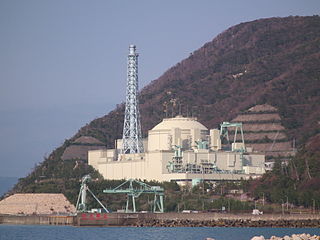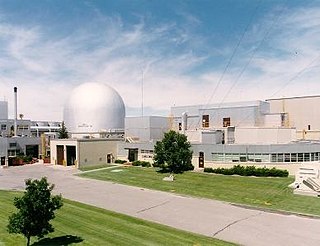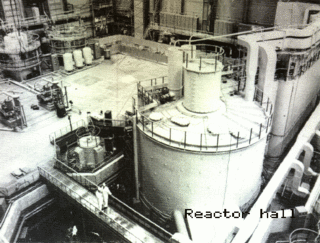
A nuclear reactor is a device used to initiate and control a fission nuclear chain reaction or nuclear fusion reactions. Nuclear reactors are used at nuclear power plants for electricity generation and in nuclear marine propulsion. Heat from nuclear fission is passed to a working fluid, which in turn runs through steam turbines. These either drive a ship's propellers or turn electrical generators' shafts. Nuclear generated steam in principle can be used for industrial process heat or for district heating. Some reactors are used to produce isotopes for medical and industrial use, or for production of weapons-grade plutonium. As of 2022, the International Atomic Energy Agency reports there are 422 nuclear power reactors and 223 nuclear research reactors in operation around the world.

A breeder reactor is a nuclear reactor that generates more fissile material than it consumes. These reactors can be fueled with more-commonly available isotopes of uranium and thorium, such as uranium-238 and thorium-232, as opposed to the rare uranium-235 which is used in conventional reactors. These materials are called fertile materials since they can be bred into fuel by these breeder reactors.

Monju (もんじゅ) was a Japanese sodium-cooled fast reactor, located near the Tsuruga Nuclear Power Plant, Fukui Prefecture. Its name is a reference to Manjusri. Construction started in 1986 and the reactor achieved criticality for the first time in April 1994. The reactor has been inoperative for most of the time since it was originally built. It was last operated in 2010 and is now closed.

Dounreay is a small settlement and the site of two large nuclear establishments on the north coast of Caithness in the Highland area of Scotland. It is on the A836 road nine miles west of Thurso.

The Savannah River Site (SRS) is a U.S. Department of Energy (DOE) reservation in the United States, located in the state of South Carolina on land in Aiken, Allendale, and Barnwell counties adjacent to the Savannah River. It lies 25 miles (40 km) southeast of Augusta, Georgia. The site was built during the 1950s to refine nuclear materials for deployment in nuclear weapons. It covers 310 square miles (800 km2) and employs more than 10,000 people.

The integral fast reactor is a design for a nuclear reactor using fast neutrons and no neutron moderator. IFR would breed more fuel and is distinguished by a nuclear fuel cycle that uses reprocessing via electrorefining at the reactor site.

The Shippingport Atomic Power Station was the world's first full-scale atomic electric power plant devoted exclusively to peacetime uses. It was located near the present-day Beaver Valley Nuclear Generating Station on the Ohio River in Beaver County, Pennsylvania, United States, about 25 miles (40 km) from Pittsburgh.

Indira Gandhi Centre for Atomic Research (IGCAR) is one of India's premier nuclear research centres. It is the second largest establishment of the Department of Atomic Energy (DAE), next to Bhabha Atomic Research Centre (BARC), located at Kalpakkam, 80 km south of Chennai, India. It was established in 1971 as an exclusive centre dedicated to the pursuit of fast reactor science and technology, due to the vision of Vikram Sarabhai. Originally, it was called Reactor Research Centre (RRC). It was renamed to Indira Gandhi Centre for Atomic Research (IGCAR) by the then Prime Minister of India Rajiv Gandhi in December 1985. The centre is engaged in broad-based multidisciplinary programme of scientific research and advanced engineering directed towards the development of fast breeder reactor technology in India.

Fermi 1 was the United States' only demonstration-scale breeder reactor, built during the 1950s at the Enrico Fermi Nuclear Generating Station on the western shore of Lake Erie south of Detroit, Michigan. It used the sodium-cooled fast reactor cycle, in which liquid sodium metal is used as the primary coolant instead of typical nuclear reactor designs cooled by water. Sodium cooling permits a more compact core, generating surplus neutrons used to produce more fission fuel by converting a surrounding "blanket" of 238U into 239Pu which can be fed back into a reactor. At full power, it would generate 430 MW of heat (MWt), or about 150 MW of electricity (MWe).

The BN-600 reactor is a sodium-cooled fast breeder reactor, built at the Beloyarsk Nuclear Power Station, in Zarechny, Sverdlovsk Oblast, Russia. It has a 600 MWe gross capacity and a 560 MWe net capacity, provided to the Middle Urals power grid. It has been in operation since 1980 and represents an improvement to the preceding BN-350 reactor. In 2014, its larger sister reactor, the BN-800 reactor, began operation.

The BN-350 was a sodium-cooled, fast reactor located at the Mangyshlak Nuclear Power Plant, located in Aktau, Kazakhstan, on the shore of the Caspian Sea.
Nuclear decommissioning is the process leading to the irreversible complete or partial closure of a nuclear facility, usually a nuclear reactor, with the ultimate aim at termination of the operating licence. The process usually runs according to a decommissioning plan, including the whole or partial dismantling and decontamination of the facility, ideally resulting in restoration of the environment up to greenfield status. The decommissioning plan is fulfilled when the approved end state of the facility has been reached.

Marcoule Nuclear Site is a nuclear facility in the Chusclan and Codolet communes, near Bagnols-sur-Cèze in the Gard department of France, which is in the tourist, wine and agricultural Côtes-du-Rhône region. The plant is around 25 km north west of Avignon, on the banks of the Rhone.
The Prototype Fast Breeder Reactor (PFBR) is a 500 MWe sodium-cooled, fast breeder reactor that is being constructed at Kokkilamedu, near Kalpakkam, in Tamil Nadu state, India. The Indira Gandhi Centre for Atomic Research (IGCAR) is responsible for the design of this reactor and BHEL is providing technology and equipment for construction of the reactor. The facility builds on the decades of experience gained from operating the lower power Fast Breeder Test Reactor (FBTR). At first, the reactor's construction was supposed to be completed in September 2010, but there were several delays. The Prototype Fast Breeder Reactor is scheduled to be put into service in December 2024, which is more than 20 years after construction began and 14 years after the original commissioning date, as of December 2023. The project's cost has doubled from ₹3,500 crore to ₹7,700 crore due to the multiple delays. The construction was completed on 4th March 2024 with commencement of core loading of the reactor hence paving the way for the eventual full utilization of India’s abundant thorium reserves.

The Zero Power Physics Reactor or ZPPR was a split-table-type critical facility located at the Idaho National Laboratory, Idaho, USA. It was designed for the study of the physics of power breeder systems and was capable of simulating fast reactor core compositions characteristic of 300-500 MWe demonstration plants and 1000 MWe commercial plants.

PRISM is a nuclear power plant design by GE Hitachi Nuclear Energy (GEH).
The BN-800 reactor is a sodium-cooled fast breeder reactor, built at the Beloyarsk Nuclear Power Station, in Zarechny, Sverdlovsk Oblast, Russia. The reactor is designed to generate 880 MW of electrical power. The plant was considered part of the weapons-grade Plutonium Management and Disposition Agreement signed between the United States and Russia. The reactor is part of the final step for a plutonium-burner core The plant reached its full power production in August 2016. According to Russian business journal Kommersant, the BN-800 project cost 140.6 billion rubles.

The BN-1200 reactor is a sodium-cooled fast breeder reactor project, under development by OKBM Afrikantov in Zarechny, Russia. The BN-1200 is based on the earlier BN-600 and especially BN-800, with which it shares a number of features. The reactor's name comes from its electrical output, nominally 1220 MWe.

ASTRID was a proposal for a 600 MW sodium-cooled fast breeder reactor, proposed by the Commissariat à l'énergie atomique (CEA). It was to be built on the Marcoule Nuclear Site in France. It was the successor of the three French fast reactors Rapsodie, Phénix and Superphénix.

Robert Louis (Bob) Ferguson was a nuclear-trained physicist and a 60-year veteran in the field of nuclear energy. He was best known for being appointed the first Deputy Assistant Secretary for Nuclear Energy Programs for the U.S. Department of Energy (DOE) by the first Energy Secretary, James Schlesinger, serving from 1978 to 1980 during President Jimmy Carter's administration.




















